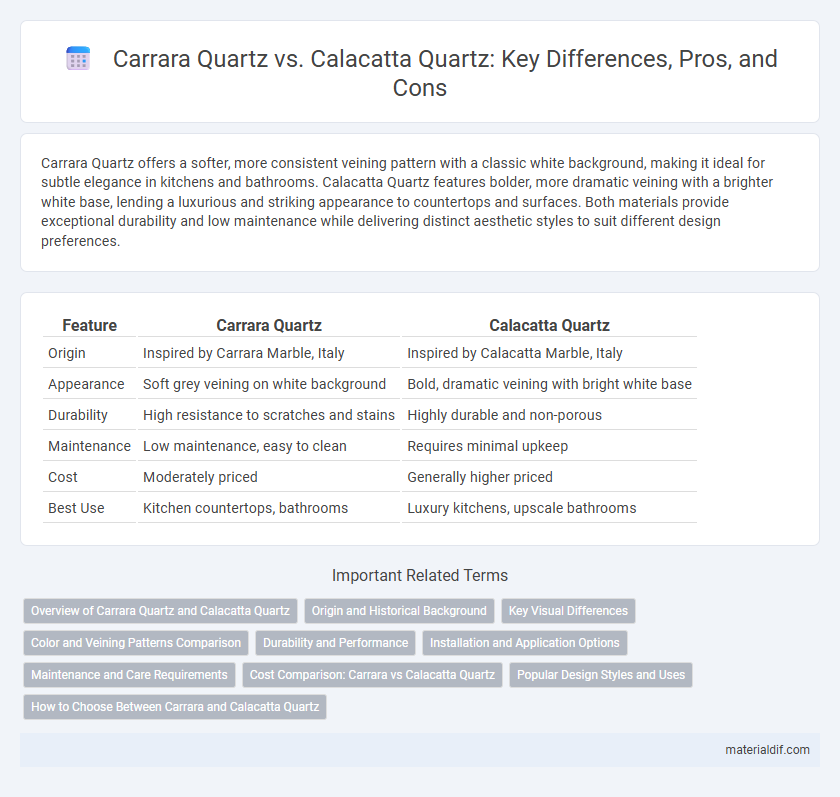Carrara Quartz offers a softer, more consistent veining pattern with a classic white background, making it ideal for subtle elegance in kitchens and bathrooms. Calacatta Quartz features bolder, more dramatic veining with a brighter white base, lending a luxurious and striking appearance to countertops and surfaces. Both materials provide exceptional durability and low maintenance while delivering distinct aesthetic styles to suit different design preferences.
Table of Comparison
| Feature | Carrara Quartz | Calacatta Quartz |
|---|---|---|
| Origin | Inspired by Carrara Marble, Italy | Inspired by Calacatta Marble, Italy |
| Appearance | Soft grey veining on white background | Bold, dramatic veining with bright white base |
| Durability | High resistance to scratches and stains | Highly durable and non-porous |
| Maintenance | Low maintenance, easy to clean | Requires minimal upkeep |
| Cost | Moderately priced | Generally higher priced |
| Best Use | Kitchen countertops, bathrooms | Luxury kitchens, upscale bathrooms |
Overview of Carrara Quartz and Calacatta Quartz
Carrara Quartz features a soft white base with subtle grey veining, closely mimicking the classic Italian marble known for its elegance and versatility in residential and commercial spaces. Calacatta Quartz distinguishes itself with a brighter white background and bolder, more dramatic veining patterns in grey or gold tones, making it a premium choice for statement countertops and luxury interiors. Both types offer durability and low maintenance, combining the beauty of natural marble with the resilience of engineered quartz.
Origin and Historical Background
Carrara Quartz is inspired by the renowned Carrara marble from Tuscany, Italy, known for its white and gray veining patterns dating back to Roman times when it was extensively used in sculpture and architecture. Calacatta Quartz mimics Calacatta marble, primarily quarried in the Apuan Mountains of Carrara, Italy, cherished since the Renaissance for its bold, dramatic veining and rarity compared to other marble types. Both types of quartz surfaces combine modern engineered durability with centuries-old marble aesthetics rooted in European historical significance.
Key Visual Differences
Carrara Quartz features subtle, soft gray veining on a white or light gray background, creating a classic and understated look. Calacatta Quartz displays bold, dramatic veining with thicker and more pronounced streaks in shades of gray and gold, set against a bright white backdrop. The distinguishable contrast in veining intensity and color saturation defines the key visual differences between Carrara and Calacatta Quartz surfaces.
Color and Veining Patterns Comparison
Carrara Quartz features a soft white background with subtle, light gray veining that creates a delicate, marble-like appearance, ideal for understated elegance. Calacatta Quartz displays a bright white base with dramatic, thicker veining in gold or dark gray, offering a bold and luxurious aesthetic. The distinct color intensity and veining patterns make Carrara Quartz suitable for minimalist designs, while Calacatta Quartz becomes a focal point in sophisticated, high-contrast interiors.
Durability and Performance
Carrara Quartz offers excellent durability with high resistance to scratches and stains, making it suitable for busy kitchens and bathrooms. Calacatta Quartz, while equally resistant to physical damage, provides a slightly denser surface that enhances its performance against heat and impact. Both types require minimal maintenance and deliver consistent long-term performance ideal for residential and commercial applications.
Installation and Application Options
Carrara Quartz offers flexible installation options due to its subtle veining, making it suitable for both traditional and contemporary applications, including kitchen countertops, backsplashes, and bathroom vanities. Calacatta Quartz features bold veining patterns that require precise matching during installation, ideal for statement pieces like large island countertops and feature walls. Both materials are engineered for durability and stain resistance, allowing for versatile use in residential and commercial projects where aesthetic impact is key.
Maintenance and Care Requirements
Carrara Quartz requires minimal maintenance, as it resists stains and scratches due to its non-porous surface, making regular wiping with mild soap and water sufficient. Calacatta Quartz also offers easy care with its durable resin and natural quartz blend, but it may need occasional sealing to preserve its veining pattern and prevent discoloration over time. Both materials are highly durable and low-maintenance compared to natural marble, providing long-lasting beauty with simple cleaning routines.
Cost Comparison: Carrara vs Calacatta Quartz
Carrara Quartz generally costs less than Calacatta Quartz, with prices typically ranging from $50 to $70 per square foot compared to Calacatta's $65 to $100 per square foot. The price difference is influenced by Calacatta Quartz's distinctive bold veining and rarity, which increases its market value. Homeowners and designers often select Carrara Quartz for budget-conscious projects without sacrificing the marble-inspired aesthetic.
Popular Design Styles and Uses
Carrara Quartz features a soft white background with subtle gray veining, making it ideal for classic, minimalist, and contemporary kitchen designs. Calacatta Quartz is known for its dramatic, bold veining on a bright white base, perfect for luxurious, high-end bathrooms and statement countertops. Both stones are popular choices for backsplashes, islands, and wall claddings due to their durability and timeless elegance.
How to Choose Between Carrara and Calacatta Quartz
When choosing between Carrara and Calacatta quartz, consider the distinct veining patterns and color tones: Carrara quartz features subtle, softer gray veins ideal for understated elegance, while Calacatta quartz showcases bold, dramatic veins on a brighter white background, perfect for making a statement. Evaluate your design style and kitchen lighting, as Carrara suits classic or minimalist aesthetics and Calacatta complements modern, high-contrast interiors. Durability and maintenance are comparable, so prioritize visual impact and overall ambiance to select the best quartz for your space.
Carrara Quartz vs Calacatta Quartz Infographic

 materialdif.com
materialdif.com